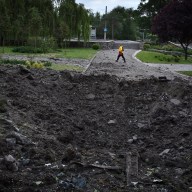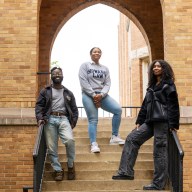 Frederick Wiseman’s “At Berkeley” explores the inner workings of a major institution.
Frederick Wiseman’s “At Berkeley” explores the inner workings of a major institution.
Credit: Zipporah Films
‘At Berkeley’
Director: Frederick Wiseman
Genre: Documentary
Rating: NR
4 (out of 5) Globes
No one does the documentary style coined “fly on the wall” as severely as Frederick Wiseman. Since 1967’s “Titicut Follies,” an exposé of the grim conditions at a mental institution, Wiseman has found ways to hide himself from the people he shoots. (One trick: He and his cameraman spend the first few weeks following people with cameras but not shooting them, until they simply become used to their presence.) But his films aren’t merely unstructured slices of life. They’re extremely structured. Every moment of a Frederick Wiseman film is there for a reason. You are meant to reflect on what’s being said, how it jibes with what else is in the film, and how it reflects what gradually appears to be the dominant theme.
That theme is often the same in Wiseman’s films. They’re studies of the inner workings of institutions, be they actual institutions like a school (this or “High School”) or a hospital (as in “Hospital”), or something more abstract like police work (as in “Law and Order”). He often comes away with the same general thesis: These organizations are all run by people who have to work together on the practical aspects of running, be they intellectual or monetary.
At four hours, “At Berkeley” is his third longest work. (The second longest, “Belfast, Maine,” runs only one minute more.) With more space than usual — some of his films run only 80-some minutes, others in the 2 ½ hour range — Wiseman has time to play more with what he’s saying. On one hand, this is another look at how a university runs, with plenty of time spent in classes and budget meetings, and with staffers cleaning halls and trimming the lawn.
But over time there grows a semi-subliminal thread in which Wiseman seems to be taking the students to task. Berkeley has a history of protests, but the ones we see are portrayed as weak, their demands too diffuse. When they take over the school library, Wiseman drifts away to non-protesting students on the lawn, relaxing, reading books and doing anything but joining in the organized vitriol. Nothing changes, and class and budget problems resume.
Of course, this is all inferred, if strongly, with an elbow in the ribs. Other times it’s a kind of Rorschach test, seeing if you can pick up strands from classes as diverse as one taught by diminutive economist Robert Reich and one on astronomy, where a professor ruminates on getting outside of the bubble of Earth (or Berkeley) and living on other planets (or at least off campus). Even if it’s less specific — or at least more open — than other Wisemans, his is a presentation of this world always worth digging through.
















